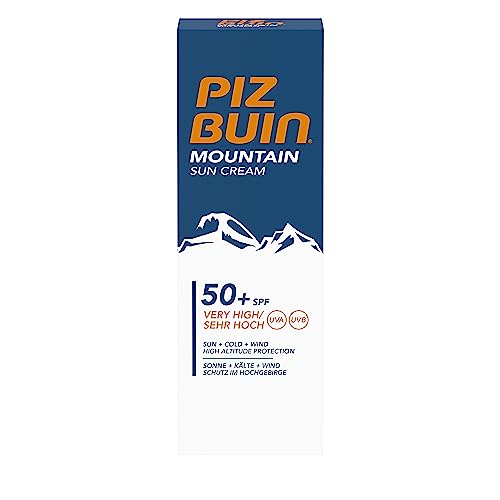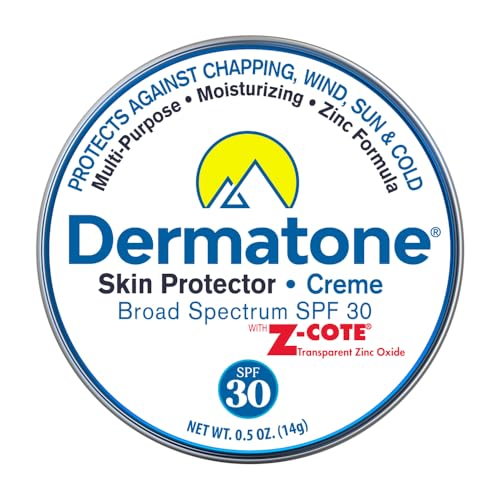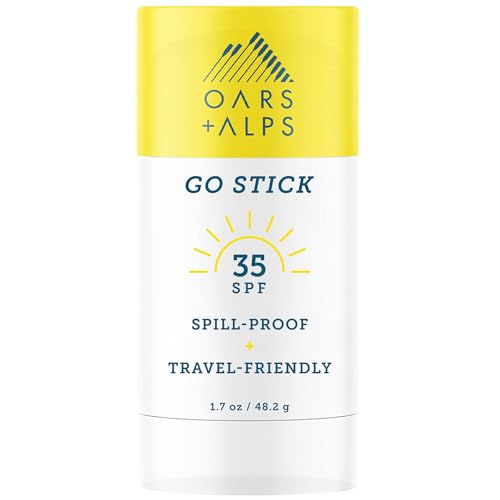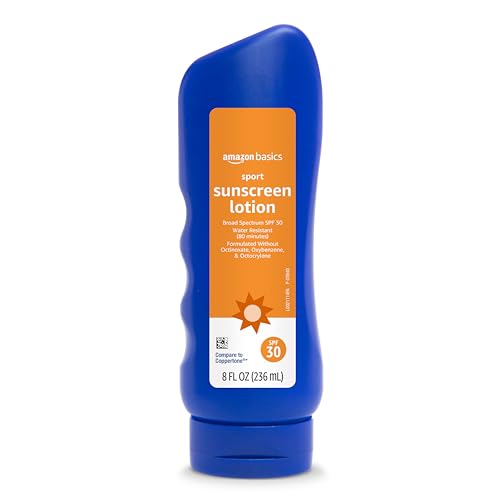Snow sunburn sneaks up fast. The cold hides how strong the glare really is, and by the end of the day your face is cooked. I’ve gone through plenty of sunscreens that looked fine on paper but only lasted a few runs.
I spend most days outside teaching, so I’ve learned what actually holds up in mountain weather. These are the ones that go on clean, stay put and keep your skin from getting wrecked.
🏆 Quick Pick
The Piz Buin Mountain Cream SPF 50+ is the best sunscreen for skiing and snowboarding. It’s one of the few formulas actually made for high-altitude conditions. It feels thicker than normal face lotion but stays on through wind, glare and sweat. It’s what I reach for on full days guiding or touring in bright snow.
Top 3 Skiing Sunscreens
Best Ski & Snowboard Sunscreen
1. Mountain by Piz Buin Cream Best Overall Pick
- Fast absorbing*, sweat and water resistant face cream is specifically designed to protect your skin from unforgiving, high-altitude sun, cold and wind exposure
- Enriched with a Cold Shield Complex, provides long lasting moisturisation, protecting the skin from extreme cold and wind
- Anti-oxidant* (In vitro test) Edelweiss, helps to protect the skin from the sun and long-term skin damage / Ultra-flat, ergonomic profile of the tube fits easily in your pocket
- High Altitude Protection & with advanced UVA/UVB sun filter technology / UVA**** Superior / Sun, cold & wind protection
- Items included: PIZ BUIN Mountain Suncream SPF 50+ 50 ml
If I could only pack one sunscreen for a ski trip, this would be it. Piz Buin has been around forever, and there’s a reason mountain guides, instructors and patrollers still use it. It goes on clean, sinks in fast and doesn’t leave that greasy layer that sticks to your balaclava.
The SPF 50+ holds up well against strong alpine conditions and it doesn’t sting when sweat runs near your eyes. You can apply once in the morning, top up after lunch and be covered all day. The small tube fits easily in a pocket too and doesn’t leak or separate in the cold.
It’s not perfect. The scent’s stronger than I’d like and while the texture is good for normal skin, it’s not rich enough for very dry faces or cracked lips. But the trade-off is worth it. You can tell it was actually made for mountain use. You can also get it a combo pack with SPF lipstick, but in all honesty there are better skiing lip balms – so I tend to buy them separately.
Pros
- Proven performance
- Rubs in clean and easy
- Doesn’t run or sting your eyes
- Lasts through long mountain days
- Feels light but protective
- Compact and leak-free tube
Cons
- Noticeable scent that not everyone likes
- Too light for very dry or chapped skin
- Costs more than basic drugstore sunscreens
2. Dermatone Skin Protector Best Cold Weather Pick
- SPF 30 SUN PROTECTION: Our Z-Cote Zinc Oxide sunscreen formula keeps your skin protected in high UV environments with broad spectrum UVA/UVB to prevent sunburns so you can stay outside for longer.
- MOISTURIZING WITH ALOE: Our face and lip balm tin is formulated to hydrate, heal, and repair your skin in any environment. Moisturizing formula is a great for dr skin. Advanced skin therpy for body and face.
- WATER AND SWEAT RESISTANT: Multi-purpose balm is a sweat & water resistant sunscreen (80 min). Great climbing, hiking, biking, sailing, surfing, fishing, camping, running, boating and ski balm.
- COLD AND WIND PROTECTION BALM: All-in-one balm and barrier cream tested in the most extreme environments from Death Valley to Everest. Our frostbite protection balm protects against cold, chapping, sunburn, & windburn.
- CONVENIENT TRAVEL TIN: Stash our durable and TSA friendly skin protection balm in your backpack, ski jacket, or anywhere else so you can have long lasting sunscreen wherever your travels take you.
Dermatone’s been a mountain staple for decades. You’ll see it in every patrol shack and instructor locker because it works when it’s cold, windy and you’ve already been out way too long.
The zinc formula gives it a thicker, waxy feel that blocks windburn and keeps your skin from cracking. It’s also used by the U.S. Ski and Snowboard Team, which is about as solid an endorsement as you’ll find (other than mine of course).

I use it on deep winter days or when I’m teaching back-to-back lessons and can’t stop to reapply. It stays on, protects well below freezing and doubles as a lip balm when your face is already wrecked.
The downside is it’s heavy. It feels tacky for a few minutes after you put it on, and it can leave a bit of a white cast if you overdo it. It’s not something I’d use for warm spring laps, but for mid-winter or high alpine days, it’s tough to beat.
Pros
- Excellent protection in wind & cold
- Works for both face and lips
- Thick barrier that stays put all day
- Compact tin lasts forever
- Trusted by guides and patrols
Cons
- Heavier, waxy feel takes getting used to
- Can leave a slight white tint
- Not ideal for sunny spring days
3. Oars + Alps Face Sunscreen Stick Instructor's Pick
- CLEAR SPF 35 STICK FOR ON-THE-GO: With Broad Spectrum UVA/UVB SPF 35 and extra-hydrating ingredients, youÔøΩll want to take it everywhere. Plus, the SPF is resistant to sweat and water for 80-minutes.
- GREAT FOR ALL SKIN TYPES: This SPF stick glides on clear, making it great for all types of skin. Use it as a face or body sunscreen without worrying about white residue (especially on hard-to-see areas like your ears and neck).
- SPILL-FREE AND TRAVEL-FRIENDLY: This travel-friendly stick wonÔøΩt spill in your bag when you take it on-the-go or when you travel.
- HYDRATING INGREDIENTS: The formula has Jojoba Oil and Sunflower Oil to moisturize, plus antioxidant-rich Alpine Caribou Moss and Vitamin E to promote skin health.
- GENTLE ON SKIN: This vegan, cruelty-free formula is fragrance-free and gentle, so it wonÔøΩt irritate sensitive or recently-shaved skin. ItÔøΩs also reef-safe and free of Oxybenzone, Octinoxate, Parabens, Phthalates, and Sulfates.
Oars + Alps is great for quick days when you just need something easy to throw on. The stick format’s convenient, especially when you’re sitting on the lift or gearing up in the parking lot. My instructor buddy gave out a few of them and everyone is now hooked.
It goes on smooth and absorbs super fast – can feel slightly greasy if you layer too much. It does hold up well against sweat and wind though. I’ve used it teaching all day in spring sun and never burned. It’s not as tough as heavier mountain creams like Piz Buin or Dermatone, but for short sessions and ease of application, it’s an easy win.
It’s the one I keep in my jacket pocket all season. Not perfect, but it’s saved my face on enough long days to earn a solid spot in the kit.
Pros
- Convenient stick for quick use
- Goes on smooth and blends easily
- Good sweat and wind resistance
- Doesn’t sting eyes or have a strong scent
- Compact and TSA friendly
Cons
- Can feel slightly greasy if applied thick
- Lower SPF than high-altitude options
- Needs reapplying on longer days
4. Amazon Basics Sport Sunscreen Best Budget Pick
- Amazon Brand - Solimo Sport Sunscreen Lotion, SPF 30 Broad Spectrum UVA/UVB Protection, 8 Fluid Ounce
For a cheap sunscreen, this one’s surprisingly solid. It’s not fancy, but it covers well and stays on through wind and sweat. I’ve used it when I don’t want to waste the good stuff and as a backup when clients inevitably forget theirs. It’s oil-free, spreads clean and doesn’t burn your eyes when you sweat.
The texture’s thinner than Piz Buin or Dermatone, so it needs a reapply or two on longer days. It also has that typical chemically sunscreen smell, but nothing overwhelming. If you’re packing for a family trip or just want something that works without draining your wallet, this is probably it.
Obviously it’s not technically “the best sunscreen for skiing” but it’ll do the job when the budget’s tight.
Pros
- Clean, non-greasy texture
- Water and sweat resistant
- Good coverage for the price
- Doesn’t sting eyes
- Big bottle lasts ages
Cons
- Needs reapplying on long or high-altitude days
- Standard sunscreen smell
- Not as protective in harsh cold or wind
5. CeraVe Sunscreen Stick Best for Sensitive Skin
- [ BROAD SPECTRUM UV PROTECTION ] 100% Mineral based sunscreen reflects UVA/UVB rays to help protect the skin. Stick sunscreen for face formulated with InVisibleZincTM Technology, a micro-fine zinc oxide that spreads easily & has a clear finish.
- [ MESS-FREE APPLICATION ] A sunscreen face stick is ideal for on-the go application for the whole family. Convenient, travel size packaging makes reapplication easy. Suitable for sensitive areas like lips, nose, earlobes and around the eyes for both kids and adults.
- [ HAWAII COMPLIANT SUNSCREEN ] Oxybenzone free, avobenzone free, and benzene free, this face sunscreen contains physical filters Zinc Oxide and Titanium Dioxide. Hawaii prohibits the sale, offer of sale and distribution of sunscreens that contain oxybenzone.
- [ 3 ESSENTIAL CERAMIDES ] Ceramides are found naturally in the skin and can become damaged with sun exposure. All CeraVe products are formulated with three essential ceramides (1, 3, 6-II) to help restore and maintain the skin’s natural barrier.
- [ GENTLE FORMULA ] Formula is oil free; fragrance free; noncomedogenic; water-resistant and suitable for sensitive skin. Recommended by the Skin Cancer Foundation as an effective; broad spectrum sunscreen. Travel Size Sunscreen. FSA Eligible & HSA Eligible
If your skin hates most sunscreens, this one’s a safe bet. CeraVe’s mineral stick is apparently fragrance-free, oil-free and packed with ceramides and hyaluronic acid (whatever that means). It basically protects without wrecking your skin barrier. It’s thick when you first apply it but settles quickly and gives proper coverage in cold, dry conditions.
My co-founder Jess keeps one her jacket pocket for touch-ups or when her skin’s already fried from wind and sun. She says it won’t sting near your eyes and doesn’t trigger breakouts after long days outside. It’s not fancy, but it works when your skin’s too beat up for anything else.
Pros
- Formula is safe for sensitive skin
- No sting near eyes
- Fragrance-free and dermatologist approved
- Holds up in dry, cold conditions
- Good pocket size for quick reapply
Cons
- Feels thicker than other sunscreens
- Leaves a light white cast if you overapply
- Feels like it wears off quicker
Ski & Snowboard Sunscreen Buying Guide
The best sunscreen for skiing and snowboarding isn’t the same stuff you’d wear at the beach. The altitude, cold air and reflection off the snow will hit your skin harder than you’d think. Trust me (and my leathery face) on that one. Here are the features to look for when choosing sun protection for the mountains.
SPF strength:
Look for SPF 30 or higher. High-altitude UV is stronger and the glare off the snow can burn you even on cloudy days. The best ski sunscreens use SPF 50 or more and hold up through sweat and wind. Choose your strength carefully based on time of year and your skin type.
Type:
Chemical-based sunscreens go on smoother, while mineral ones (zinc oxide or titanium dioxide) are better if you’ve got sensitive or dry skin. Most skiers and snowboarders have both – a lotion for morning application and a small stick for reapplying on lifts.
Texture:
Typical sunscreens can feel feel greasy or shiny. You want a dry-touch or matte finish that won’t smear your goggles or feel heavy on your face. Sticking to the inside of your balaclava is indescribably gross.
Cold-weather resistance:
Ski sunscreen needs to handle freezing temps. Some regular sunscreens get watery or separate in the cold. Mountain formulas like Piz Buin and Dermatone are made for this exact environment.
Format:
Sticks are easy to use mid-day with gloves on. Tubes or bottles are fine for morning layers, but they’re not as pocket-friendly when you’re riding.
Bottom Line:
Whether you’re a skier or snowboarder, the best sunscreen is the one you’ll actually use. A clean feel, solid SPF and cold-weather stability matter more than fancy ingredients. If your sunscreen looks, smells or feels weird, you’re going to burn (‘cos you will definitely not be applying that shit to your face!)
💡 Pro Tip
The best ski sunscreen still won’t protect your face from everything. On windy days, cover up with a good face mask or balaclava and reapply around your nose and cheeks after lunch. It makes a big difference when the temps drop or the wind starts to sting.
Final Thoughts
Most days I start with Piz Buin as a base layer, then carry Dermatone or Oars + Alps (my current favorite) for wind, cold and quick top-ups on the hill. Piz Buin covers bright alpine sun. The others are your shield when the air hurts your face. That mix has kept my skin in one piece through long teaching days and back-to-back tours. Hope that helps!










